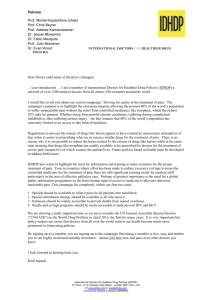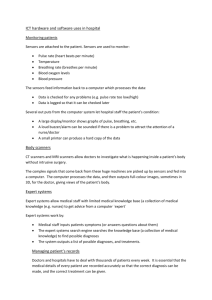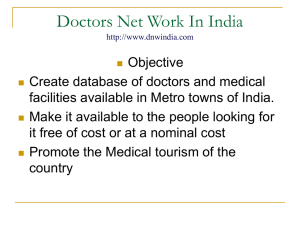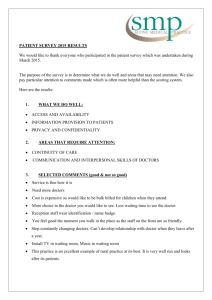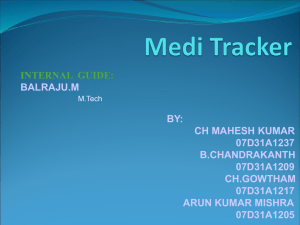The Art of Medicine – A Task of Strategy Yskert v. Kodolitsch
advertisement
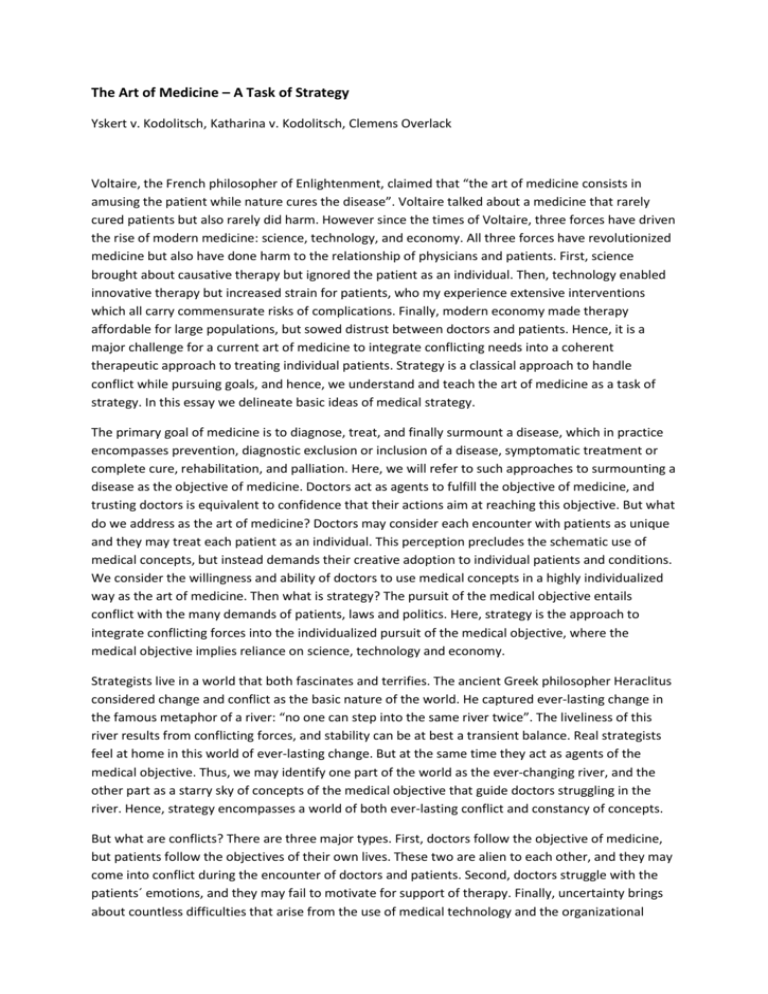
The Art of Medicine – A Task of Strategy Yskert v. Kodolitsch, Katharina v. Kodolitsch, Clemens Overlack Voltaire, the French philosopher of Enlightenment, claimed that “the art of medicine consists in amusing the patient while nature cures the disease”. Voltaire talked about a medicine that rarely cured patients but also rarely did harm. However since the times of Voltaire, three forces have driven the rise of modern medicine: science, technology, and economy. All three forces have revolutionized medicine but also have done harm to the relationship of physicians and patients. First, science brought about causative therapy but ignored the patient as an individual. Then, technology enabled innovative therapy but increased strain for patients, who my experience extensive interventions which all carry commensurate risks of complications. Finally, modern economy made therapy affordable for large populations, but sowed distrust between doctors and patients. Hence, it is a major challenge for a current art of medicine to integrate conflicting needs into a coherent therapeutic approach to treating individual patients. Strategy is a classical approach to handle conflict while pursuing goals, and hence, we understand and teach the art of medicine as a task of strategy. In this essay we delineate basic ideas of medical strategy. The primary goal of medicine is to diagnose, treat, and finally surmount a disease, which in practice encompasses prevention, diagnostic exclusion or inclusion of a disease, symptomatic treatment or complete cure, rehabilitation, and palliation. Here, we will refer to such approaches to surmounting a disease as the objective of medicine. Doctors act as agents to fulfill the objective of medicine, and trusting doctors is equivalent to confidence that their actions aim at reaching this objective. But what do we address as the art of medicine? Doctors may consider each encounter with patients as unique and they may treat each patient as an individual. This perception precludes the schematic use of medical concepts, but instead demands their creative adoption to individual patients and conditions. We consider the willingness and ability of doctors to use medical concepts in a highly individualized way as the art of medicine. Then what is strategy? The pursuit of the medical objective entails conflict with the many demands of patients, laws and politics. Here, strategy is the approach to integrate conflicting forces into the individualized pursuit of the medical objective, where the medical objective implies reliance on science, technology and economy. Strategists live in a world that both fascinates and terrifies. The ancient Greek philosopher Heraclitus considered change and conflict as the basic nature of the world. He captured ever-lasting change in the famous metaphor of a river: “no one can step into the same river twice”. The liveliness of this river results from conflicting forces, and stability can be at best a transient balance. Real strategists feel at home in this world of ever-lasting change. But at the same time they act as agents of the medical objective. Thus, we may identify one part of the world as the ever-changing river, and the other part as a starry sky of concepts of the medical objective that guide doctors struggling in the river. Hence, strategy encompasses a world of both ever-lasting conflict and constancy of concepts. But what are conflicts? There are three major types. First, doctors follow the objective of medicine, but patients follow the objectives of their own lives. These two are alien to each other, and they may come into conflict during the encounter of doctors and patients. Second, doctors struggle with the patients´ emotions, and they may fail to motivate for support of therapy. Finally, uncertainty brings about countless difficulties that arise from the use of medical technology and the organizational environment of medicine. These difficulties contribute to turning the smooth medicine of textbooks into the arduous medicine of the real world. Doctors may fail to integrate the goals of patients, may not succeed in enlisting patients´ emotional support of treatment, or they may not be able to foresee difficulties that may interfere with therapy. These three situations correspond to three major types of therapeutic failure. The three major types of failure may be illustrated with the example of a patient receiving pacemaker implantation for recurrent syncope. Imagine the patient to be a professional hunter, in whom it turns out after implantation that the recoil of his rifle on the right side of his chest would damage the pacemaker; he now has to give up hunting or undergo re-implantation of the pacemaker on the left side. This therapy is ineffective for failing to integrate patients´ objectives. In our second example, the patient values his autonomy above all else and cannot accept his dependency on artificial devices. He intentionally misses pacemaker check-ups and suffers syncope after depletion of the battery. This therapy fails because the patient was not motivated to support therapy. In the third example, our patient experiences syncope due to leads that became dislocated while the patient was using a chainsaw shortly after implantation. This therapy is inefficient because of lack to communicate risks of implantation. What are the factors that fuel conflicts? There are three factors, which all claim superiority over the objective of medicine: politics, emotions, and uncertainties. Political factors include ethics, laws, economy, and personal goals of patients, which may come into conflict both between each other, and with the objective of medicine. Doctors who do not comply with ethics or laws may risk their job or even end up in jail. But politics have two faces, bearing both conflict and meaning, where for example democratic politics mandates medicine to serve humanity. Another factor is emotion. Disease often inspires deeply felt emotions such as pain, anger, despair, blame, and hate. Emotions may overpower patients, and they also affect doctors. Emotions may remain weak, but they may “burn up” entire medical encounters. Doctors who ignore emotions will struggle endlessly with their patients and may even spend time in court. But emotions can also be regarded as having two faces, where negative emotions can turn into positive emotions that help patients to surmount a disease. The third factor is uncertainty, which adds a question mark to all medical data including history, diagnosis, prognosis, and medical evidence, and which puts medical decisions on shaky grounds. But uncertainty also gives rise to ubiquitous resistance of the medical environment, and thus it brings about minor incidents and major accidents. Doctors who ignore uncertainty will get caught by surprises and fail to reach their medical goals. But uncertainty also has two faces, bearing both risk and chance. How can insights about these factors translate into principles of strategy? We have identified politics, emotion and uncertainty as the three factors that rule the river of Heraclitus. Their specific mixture accounts for uniqueness and individuality of each encounter. And all three forces have one face that challenges therapy, and another that enables success. Three basic principles may link these three factors to strategic action: holism, judgement and dialogue. We define Holism in strategy as action to integrate conflicting factors into comprehensive success. Hence, therapy is effective when it is in accordance with ethics, laws, economy, and objectives of individual patients, therapy is motivated when patients emotions support intervention, and therapy is effective when intervention reaches the medical goal. But in strategy holism always is aware that forces which were just integrated may disintegrate at any time. Hence, strategists, like animal trainers, must remain aware of the lions. Imagine a heavy smoker with exacerbation of chronic obstructive pulmonary disease who received extensive counselling and motivation to quit smoking. He remained abstinent in hospital, but smoked again the first day he returned to his fellows. Judgment has to accomplish the adequate evaluation of forces, where doctors need cognitive intelligence for judgment of political factors, emotional intelligence for emotions, and common sense to anticipate resistances and complications. But judgment carries the threat of misconception which may result in applying the wrong concept, just like following the wrong star. Imagine the smoker again, where the doctor provides plethora of information about medical cons of smoking because he misinterprets his patients´ behavior as lack of knowledge rather than as lack of emotional ability. Finally, the dialogue of doctors and patients mirrors factors that rule the river of Heraclitus, where doctors and patients challenge and change each other through the flow of words, thoughts and feelings. But doctors are agents of the medical objective, and hence dialogue turns into negotiation when it comes to patients´ objectives, into motivation when it comes to emotions, and into didactics when it comes to enabling patients to cope with risks. We introduced strategy as a general approach, but there is also a specific task of strategy as compared to tactics: Strategy identifies the goals of treatment, determines time, methods and sequence of interventions and selects the medical means to reach these goals, whereas tactics is the use of medical means to reach a medical goal by medical interventions such as dialogue, medication, percutaneous intervention, or surgery. Thus, tactics ensure successful delivery of intervention. Strategy and tactics serve the task to integrate politics, emotions, and uncertainties into the pursuit of medical objectives, where both focus on different factors. How can physicians integrate politics? The objectives of medicine are well-defined. But patients lead their individual and colourful lives and their personal goals are diverse. For example, a boxer wants to continue a title fight despite severe bleeding, a sailor hides malaria for not wanting to leave his ship, and an elderly lady accepts intervention for an acute heart attack only after feeding her dogs. Hence, doctors negotiate personal objectives of patients, but at the same time they have to consider ethics, laws, and economy. This negotiation is the showdown and masterpiece of medical strategy. The negotiation may be imaged as reversible figure, where the focus of doctors shifts constantly between two views of their task: One as the pursuit of the medical objective and the other as the pursuit of ethics, laws, economy, and individual goals of patients. Since these goals are heterogeneous, individual, and ever-changing, strategy, in contrast to tactics, is a creative art rather than a technical discipline. Successful bonding of diverging goals of politics and medicine ensures acceptance of intervention, which we define as an efficient therapy. How can physicians integrate emotions? Intervention is a coin with two sides, where one side is the action of doctors, and the other side is the action of patients. Patients carry the highest burden of therapy, and their actions require cooperation with physicians during interventions, carrying out treatment plans, taking initiatives to surmount a disease, changing life-styles, or integrating a disease into their social life. Patients are needed to emotionally identify with medical goals and interventions, and their motivation is needed during intervention for supporting actions. Establishing emotional support while planning a therapy is a task of strategy, and to motivate patients during intervention is a task of tactics. How can physicians integrate uncertainty? Uncertainty comes to life through action, and thus mastering uncertainty is a primary task of tactics. Hence, tactics is a discipline that teaches and trains doctors to master uncertainties through routines, skills and techniques of adaption to unique conditions. But patients also face uncertainty, and thus doctors need didactic skills to inform patients about uncertainties adequately and to teach them how to master these. Thus, tactics is a discipline of mastering uncertainty to ensure that intervention reaches its medical goal. Finally, how can strategy teach the art of medicine? Certainly, the strategy approach does not provide clear-cut agendas, check-lists, or algorithms that can be schematically executed. Rather than as a grey-zone of science, strategy understands medicine as an art, where the knowledge of science gets transformed into concepts of action. In this art only medical objectives allow for the standardizations of science and technology. But there is the other side, the lives of individual human beings, who have their own objectives and emotions which oppose standardization. Hence, strategy encourages doctors to see their actions as a reversible figure, where they use judgment and creativity to build bridges to connect the medical objective with every individual patient. Here, the strategy approach provides an understanding of how to build bridges. And it may explain novices of the art of medicine how to deal with forces they meet in the river of Heraclitus when they struggle for holistic success of therapy.

